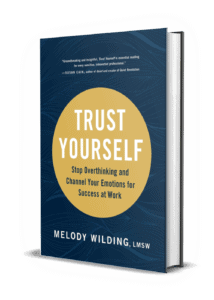How do you stop yourself from crying at work?
This is a question one of my clients, Victoria, asked during coaching.
You see, Victoria was a professional powerhouse. Her determination, smarts, and savvy rocketed her to the top of the food and beverage industry. Victoria’s peers regarded her as influential within the company. This was further evidenced by a recent promotion to managing director of her division.
But in our first coaching session, Victoria sheepishly hung her head and said:
“I can’t stop myself from crying when there’s conflict. Any time I feel put under pressure, the waterworks start. How do I control my emotions?”
Victoria’s confession didn’t surprise me.
As a coach to Sensitive Strivers, I work with leaders like Victoria – intelligent, accomplished individuals who think and feel everything more deeply.
Sensitive Strivers are biologically predisposed to have more intense emotional responses. Because we have more finely attuned nervous systems, we become stressed more easily, which can oftentimes show up in the form of tears.
Crying is also more common for female Sensitive Strivers because our bodies produce the hormone prolactin (responsible for tear production).
Reasons Why We Cry at Work
Crying is a basic human response, usually when something sad or upsetting happens. But the reasons Sensitive Strivers cry is more complex and can be an emotional reaction to:
- Frustration and stress
- Confrontation or conflict
- Pressure from feeling evaluated or judged
- Deep passion and investment
- Burnout and exhaustion
- Witnessing injustice
How to Stop Crying at Work
Let me be clear: there is nothing wrong with having emotions in the workplace. In fact, they can be your superpower. Your emotions can be a valuable source of sensory intelligence that helps you make better decisions, empathize with others, and work more effectively.
But it’s important to remember that emotional regulation is a key leadership behavior. Meaning, there’s great strength in influencing which emotions you have, when you have them, and how you experience and express them.
That’s why whenever clients like Victoria come to me wanting to understand how to stop themselves from crying at work, we focus mainly on how managing their emotions translates to greater confidence in themselves and assertiveness in their interactions with others.
Here are nine ways to stop yourself from crying at work so you can gain composure and put your best self forward.
Every technique won’t be applicable to every situation, so pick what works for you.
1. Pay attention to your physiology
Crying is typically an emotional reaction to stress, which sends your body into fight or flight. When you experience an emotion, your brain releases certain neurochemicals like cortisol and adrenaline. Crying is your body’s way of trying to bring itself back into homeostasis.
You can access calm without shedding a tear by controlling your breathing. It may sound simple, but controlled breathing is scientifically proven to lower stress and bring you back to a state of equilibrium.
Before, after, or during a stressful encounter, you can try box breathing – a method used by the Navy SEALS. It involves breathing in for a count of four, holding it for a count of four, breathing out for the count of four, and holding the out-breath for a count of four. Repeat three times.
2. Displace your angst
If you know you’re going into a situation where you could become emotional, take something with you that you can squeeze or fiddle with. This can be a small stress ball, medallion, or stone. You can even grasp tightly onto your pen.
Channeling your frustration into an object will ground you inconspicuously. Your body needs a way to process and release the stress, so at least this way, it’s through the object and not your eyes.
3. Cool down
Keep an ice-cold glass of water by your side and drink up as you feel the tears coming on. This lowers your body temperature (which goes up when you’re getting emotional). This also gets rid of the lump at the back of your throat, called the glottis.
4. Look up
Slightly tip your head upwards. This helps take your focus away from the immediate source of your tears (likely the other person or people in front of you). It also cuts the flow of tears and pools them, so they don’t run down your face.
5. Separate yourself from the situation
Request five minutes to gather your thoughts and step outside the room. If you’re on a video call, sign off, get up off your chair, and move to a different location. The change of scenery quickly creates distance between you and your reactions. It’s an age-old tactic because it works!
6. Redirect your focus
In the moment, right before tears flow, your focus is likely entirely internal. You’re trapped in your head worrying that you’re going to look like a fool and humiliate yourself. Your inner critic is going wild. Not exactly a recipe to be present and powerful in an interaction!
Instead of becoming self-conscious or overly preoccupied with the reason you’re crying, think of something entirely different. Imagine the happiest moment of your life. See the person in front of you with a silly outfit or hat on. Contort the situation in your mind’s eye, so you are less negatively influenced by it.
7. Play the observer
As William Ury says, go to the balcony. With this strategy, you imagine yourself walking out to a balcony overlooking the situation, almost as if you were watching a play happening below you.
The “balcony” is a metaphor for detaching yourself from the situation and viewing it as a neutral third party would. From this perspective, you can be less emotional about the problem in front of you.
8. Try A FEW body hacks
Some people say that pinching the skin between their thumb and pointer fingers helps. As does pressing your tongue to the roof of your mouth.
9. Embrace it
Sometimes you can’t and shouldn’t hold back tears. You don’t need to–and shouldn’t–apologize for your reaction. Crying signals you have mental and emotional depth, care deeply about your work and are passionate about what you do.
Nevertheless, it can help to give other people an insight into what you’re feeling from a position of strength, so give context for your emotions. For example, here are some ways you can reply:
- “As you can see, I’m feeling pretty invested in this, and it’s hitting me pretty hard.”
- “You can see I’m having a strong reaction, and that’s because I really value our working relationship and want to make it successful.”
- “I’m a deep processor, so thank you for giving me space to take in what you’ve said. I’m listening to your feedback and appreciate everything you’re sharing with me.”
It’s human to have emotions. But what makes you a great leader is how you choose to respond and communicate when those emotional reactions do arise. If you take ownership of your feelings and reactions, it conveys strength and confidence that others will respect.
Check out the Ultimate Guide for Sensitive Strivers for free resources to outsmart imposter syndrome, stop second-guessing yourself, and much more.









